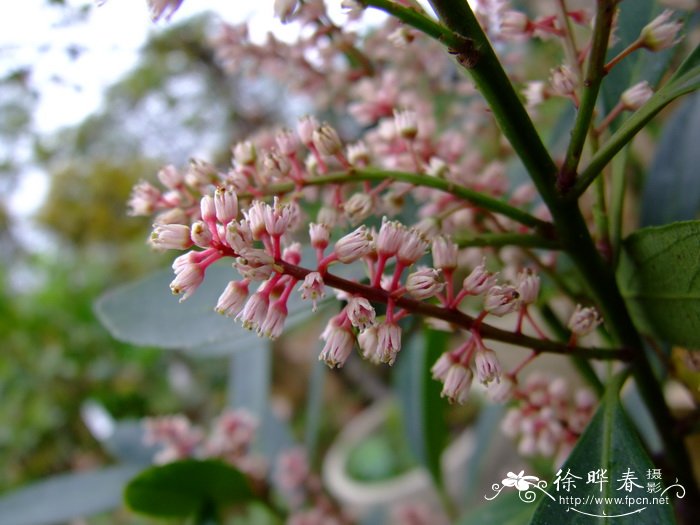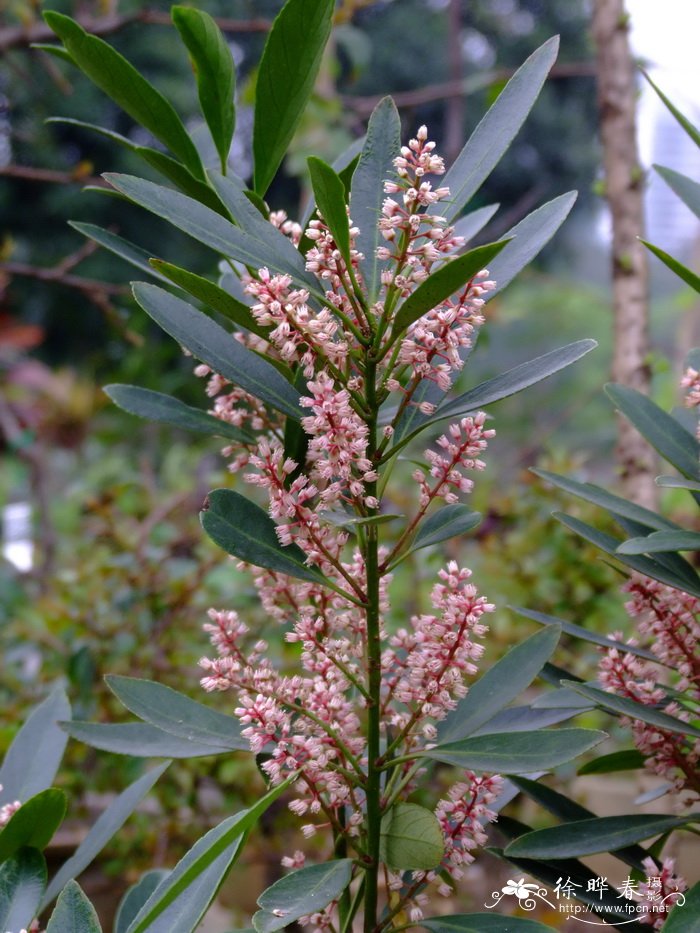阳春鼠刺Itea yangchunensis
中文名(Chinese Name):阳春鼠刺
学名(Scientific Name):Itea yangchunensis S. Y. Jin
英文名(English Common Name):
别名(Chinese Common Name):
异名(Synonym):
科属(Family & Genus):虎耳草科(Saxifragaceae)鼠刺属
形态特征(Description):灌木叶厚革质,长圆形或长圆状椭圆形,长5.5-7厘米,宽1.7-2.5厘米,先端圆形或钝,基部宽楔形,边缘除近基部外具密细锯齿,平时多少背卷,上面深绿色,下面淡绿色,两面无毛,有明显的腺体,侧脉5对,弧状弯,第三级脉平行且连接或网状;侧脉和网脉在两面极明显;叶柄粗壮,长6-7毫米,无毛。总状花序腋生,常短于叶,长3-5厘米;花序轴及花轴被短柔毛;花较少数,2-3个簇生,稀单生;萼筒浅杯状;萼片矩圆形,长3毫米。蒴果锥状,长约6毫米,干时黑色,被疏短柔毛或近无毛。果期11月。
分布(Distribution):特产广东,生于溪边。
用途(Use):
引自中国植物志英文版:FOC Vol. 8 Page 426
Itea yangchunensis S. Y. Jin, Acta Phytotax. Sin. 33: 497. 1995.
阳春鼠刺 yan chu shu ci| Saxifragaceae | Itea
Shrubs or small trees. Branchlets terete, glabrous. Petiole stout, 6-7 mm, glabrous; leaf blade abaxially pale green, adaxially dark green, oblong or oblong-elliptic, 5.5-7 × 1.7-2.5 cm, thickly leathery, both surfaces glabrous, conspicuously glandular punctate, secondary veins in ca. 5 pairs, arcuate curved, tertiary veins both parallel and reticulate, secondary and reticulate veins prominent on both surfaces, margin ± revolute when dry, densely serrulate except near base, apex rounded or obtuse. Racemes axillary, often longer than leaves, 3-5 cm; rachis and pedicels sparsely puberulous; bracts early deciduous. Flowers few, usually 2- or 3-clustered, rarely solitary. Calyx shallowly cupular; lobes oblong-lanceolate, ca. 3 mm, glabrous. Capsule turning black when dry, conical, ca. 6 mm, sparsely puberulous or subglabrous. Fr. Nov.
* Streamsides. SW Guangdong (Yangchun Xian).
This species is similar to Itea coriacea, but differs in having leaves smaller, shorter than the racemes, with a short, stout petiole and a glandular blade with prominent secondary and reticulate veins and a rounded or obtuse apex.


(责任编辑:徐晔春)
学名(Scientific Name):Itea yangchunensis S. Y. Jin
英文名(English Common Name):
别名(Chinese Common Name):
异名(Synonym):
科属(Family & Genus):虎耳草科(Saxifragaceae)鼠刺属
形态特征(Description):灌木叶厚革质,长圆形或长圆状椭圆形,长5.5-7厘米,宽1.7-2.5厘米,先端圆形或钝,基部宽楔形,边缘除近基部外具密细锯齿,平时多少背卷,上面深绿色,下面淡绿色,两面无毛,有明显的腺体,侧脉5对,弧状弯,第三级脉平行且连接或网状;侧脉和网脉在两面极明显;叶柄粗壮,长6-7毫米,无毛。总状花序腋生,常短于叶,长3-5厘米;花序轴及花轴被短柔毛;花较少数,2-3个簇生,稀单生;萼筒浅杯状;萼片矩圆形,长3毫米。蒴果锥状,长约6毫米,干时黑色,被疏短柔毛或近无毛。果期11月。
分布(Distribution):特产广东,生于溪边。
用途(Use):
引自中国植物志英文版:FOC Vol. 8 Page 426
Itea yangchunensis S. Y. Jin, Acta Phytotax. Sin. 33: 497. 1995.
阳春鼠刺 yan chu shu ci| Saxifragaceae | Itea
Shrubs or small trees. Branchlets terete, glabrous. Petiole stout, 6-7 mm, glabrous; leaf blade abaxially pale green, adaxially dark green, oblong or oblong-elliptic, 5.5-7 × 1.7-2.5 cm, thickly leathery, both surfaces glabrous, conspicuously glandular punctate, secondary veins in ca. 5 pairs, arcuate curved, tertiary veins both parallel and reticulate, secondary and reticulate veins prominent on both surfaces, margin ± revolute when dry, densely serrulate except near base, apex rounded or obtuse. Racemes axillary, often longer than leaves, 3-5 cm; rachis and pedicels sparsely puberulous; bracts early deciduous. Flowers few, usually 2- or 3-clustered, rarely solitary. Calyx shallowly cupular; lobes oblong-lanceolate, ca. 3 mm, glabrous. Capsule turning black when dry, conical, ca. 6 mm, sparsely puberulous or subglabrous. Fr. Nov.
* Streamsides. SW Guangdong (Yangchun Xian).
This species is similar to Itea coriacea, but differs in having leaves smaller, shorter than the racemes, with a short, stout petiole and a glandular blade with prominent secondary and reticulate veins and a rounded or obtuse apex.
(责任编辑:徐晔春)
踩一下[0]

顶一下[1]